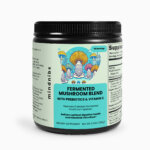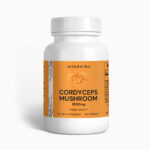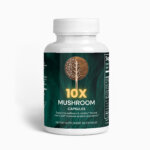
“Taste the Wild: What Does Lion’s Mane Mushroom Taste Like?”
Step off the beaten path of familiar flavors and into the mesmerizing world of mycology, where the Lion’s Mane mushroom reigns as a culinary treasure trove just waiting to be discovered. This magnificent fungus, reminiscent of a white cascading waterfall or perhaps the proud mane of the king of the jungle itself, is more than just a feast for the eyes. With taste buds alight with curiosity, you might find yourself asking: What does Lion’s Mane mushroom taste like?
Imagine, if you will, a dance of flavor notes somersaulting across your palate, the subtlety of seafood merging with the earthy whispers of the forest floor. This is no ordinary mushroom; this is a gastronomic experience, a foray into the unconventional, a bold indulgence that promises to both mystify and satisfy the culinary adventurer in you.
Join us as we embark on a flavorful quest to unveil the enigma wrapped in white, delicate spines. Whether you’re a fervent foodie or a nutrition ninja on the prowl for the next superfood sensation, the Lion’s Mane offers an allure that is hard to ignore. Keep reading, and let’s together unravel the mystery behind the taste of the wild that is the Lion’s Mane mushroom. Let your senses be your guide; it’s time to taste the untamed, the unexpected, the utterly unforgettable.
Table of Contents
- Unveiling the Mystery: The Unique Flavor Profile of Lion’s Mane Mushroom
- From Forest to Fork: Exploring the Texture and Aroma of Lion’s Mane
- The Culinary Chameleon: How Lion’s Mane Adapts in Different Dishes
- Seafood without the Sea: Comparing Lion’s Mane to Crab and Lobster
- Infusing Your Cuisine: Simple Ways to Cook with Lion’s Mane
- Pairing Perfection: What Foods and Wines Complement Lion’s Mane Mushroom
- Savor the Benefits: Nutritional Advantages of Adding Lion’s Mane to Your Diet
- The Forager’s Delight: Where to Find and How to Identify Lion’s Mane Mushroom
- Preserving the Delicacy: Tips for Storing and Preserving Lion’s Mane
- Elevate Your Palate: Creative Recipes to Showcase Lion’s Mane Mushroom
- Q&A
- Closing Remarks
Unveiling the Mystery: The Unique Flavor Profile of Lion’s Mane Mushroom

Embark on a culinary journey into the forested realms where the Lion’s Mane mushroom reigns supreme. This distinctive fungus boasts an intricate flavor profile that astonishes the palate. Not quite the usual earthiness of portobellos or the savoriness of shiitakes, Lion’s Mane presents a flavor surprise resembling seafood, with many likening it to succulent crab or tender lobster when it’s cooked just right.
Beneath its shaggy exterior, this fungi delicacy hides hints of a mildly sweet and meaty taste. It’s truly a vegetarian’s dream for creating sumptuous dishes that don’t skimp on depth of flavor. Imagine crafting a ’meaty’ experience without a trace of animal protein, and Lion’s Mane stands at the forefront of this magical transformation.
The Lion’s Mane doesn’t just tantalize taste buds; its texture is equally beguiling. Upon cooking, it transforms into a delicacy with a delightfully chewy texture, much like that of well-cooked scallops. An exquisite canvas for culinary innovation, this mushroom soaks up the surrounding flavors in a dish, making it an excellent ingredient for:
- Savory sautés with a knob of butter and a sprinkle of garlic
- Opulent risottos, lending a creamy consistency and a touch of opulence
- Rich pasta sauces, where it imparts a luxurious seafood-esque flair minus the ocean catch
To truly appreciate the gastronomic allure of Lion’s Mane, consider its compatibility with various herbs and spices. A simple table with pairings can guide you on your journey to unlock the full potential of this gourmet delight:
| Ingredient | Flavor Synergy |
|---|---|
| Thyme | Accentuates earthy notes |
| Tarragon | Complements the subtle sweetness |
| Parsley | Brings a fresh, clean aftertaste |
| Lemon Zest | Enhances with a citrusy zing |
| White Wine | Introduces a sophisticated depth |
The Lion’s Mane mushroom offers a culinary riddle worth every chef’s ponder. Its complex flavors and adaptable nature make it an unparalleled ingredient in the world of mushrooms. Whether you’re a seasoned gourmet or an adventurous foodie, the Lion’s Mane is an exotic choice that promises a delightful surprise on every plate.
From Forest to Fork: Exploring the Texture and Aroma of Lion’s Mane

Embark on a culinary adventure with one of nature’s most unique offerings – the Lion’s Mane mushroom. As you slice through its shaggy, white exterior, you’ll discover why this wild delicacy has captivated both foragers and foodies alike. The texture, a delicate intersection between meaty and tender, closely resembles that of succulent seafood, particularly crab or lobster. A gentle sauté brings out its best qualities, revealing a chewy yet soft consistency that truly sets it apart from its fungal counterparts.
Unmistakable in the forest, this mushroom’s intricate, cascading spines emit an aroma that’s both earthy and fresh, hinting at its deep woodland roots. When it comes to culinary use, however, the Lion’s Mane is surprisingly versatile. Whether steeped in a savory broth or perched atop a sizzling steak, it absorbs and complements the flavors it encounters. Here’s a taste of what you can expect:
- Seafood Substitute: A natural choice for vegan and vegetarian dishes, mimicking the flavor of crustaceans without a hint of the ocean.
- Sautéed Sensation: When lightly browned in butter or olive oil, it develops a rich, umami character that’s robust yet refined.
- Soup Enhancer: The spongy texture soaks up savory notes in soups and stews, adding a layer of complexity to each spoonful.
For those curious about the flavor profile in a more structured overview, the following table provides a snapshot of the sensory experience:
| Texture | Aroma | Flavor Pairings |
|---|---|---|
| Meaty to tender | Earthy with a hint of sweetness | Herbs, Garlic, Butter |
| Chewy when seared | Fresh woodland scent | White Wine, Citrus, Parsley |
| Soft in soups | Subtly fragrant | Thyme, Cream, Shallots |
When prepared with care, the Lion’s Mane rises from a simple fungus to a culinary centerpiece. Its distinct texture and aroma are not just a treat for your taste buds but also a testament to the mushroom’s wild origins. Allow the natural essence of the forest to transform your next dish, bringing the outdoors right to your fork. Savor the experience – it’s not every day that you get to taste something so wild, so complex, and so utterly delicious.
The Culinary Chameleon: How Lion’s Mane Adapts in Different Dishes

Imagine a single ingredient that morphs with every dish, transforming mere meals into symphonies of flavor. That’s the magic of the lion’s mane mushroom. In the culinary world, this fluffy, white fungus is akin to a sponge, soaking up the essence of the ingredients it shares a pan with. Whether it’s a savory broth or a tangy marinade, lion’s mane absorbs and amplifies the flavors, making each bite an experience to savor.
Consider the versatility of lion’s mane in classic comfort dishes:
- In a creamy risotto, its tender tendrils become lush and smooth, infusing each grain of arborio rice with a luxurious, seafood-like savoriness.
- When tucked into a pot pie, lion’s mane mushrooms turn into savory morsels that elevate the hearty filling, weaving an earthy undertone through the buttery crust.
Food enthusiasts revel in its uncanny ability to emulate the flavors of the sea. Lion’s mane makes an exquisite substitute for seafood, astounding even the most discerning palates:
- Chopped finely and sautéed with garlic, it becomes an impeccable stand-in for crab in a plant-based cake, golden and crispy on the outside.
- Marinated and grilled, its fibrous texture takes on a charred exterior, reminiscent of grilled calamari, without a hint of the ocean’s brine.
| Dish Inspiration | Flavor Profile | Culinary Role |
|---|---|---|
| Risotto | Seafood-Like | Texture Enhancer |
| Pot Pie | Earthy | Savory Filler |
| Crab Cakes | Crab Substitute | Protein Source |
| Grilled ‘Calamari’ | Chargrilled | Seafood Alternative |
Its adaptability doesn’t end with taste and texture. The nutritional profile of lion’s mane is just as impressive, packing a punch with essential vitamins and minerals. It’s an effortless way to introduce a health boost to any dish without sacrificing an ounce of flavor. So, embark on a culinary journey with lion’s mane, and let your taste buds be your compass to new and exciting flavor landscapes.
Seafood without the Sea: Comparing Lion’s Mane to Crab and Lobster
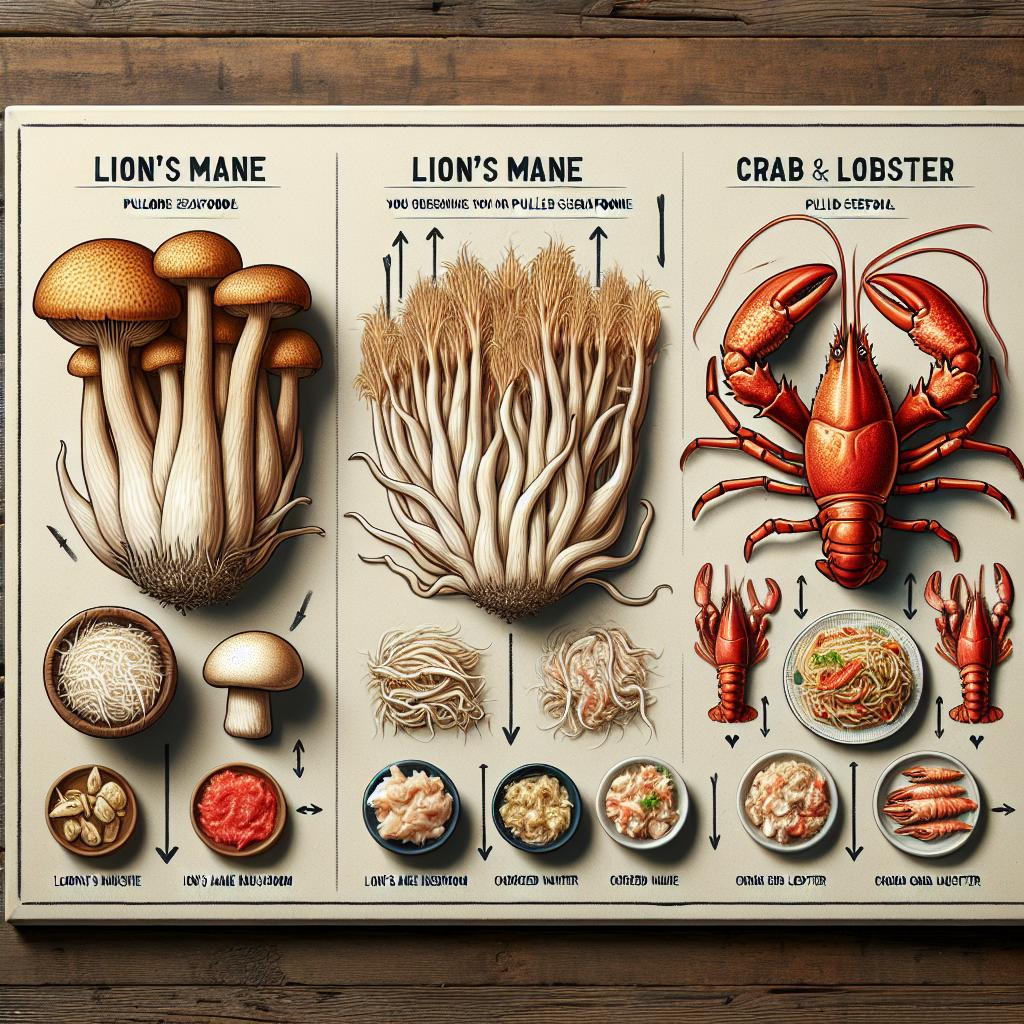
Embarking on a culinary adventure with lion’s mane mushrooms is akin to diving into an oceanic treasure trove – without getting your feet wet. Renowned for its seafood-esque flavor profile, this shaggy, globe-shaped delight is causing waves among gastronomes for its remarkable resemblance to some of the sea’s finest offerings. Imagine the distinct taste notes of crab and lobster, subtly infused with earthy tones; that’s the essence of lion’s mane for you.
The textural experience of lion’s mane is another high tide of its charm. As you savor each bite, your palate can be deceived into thinking it’s indulging in the tender, flaky consistency of cooked crab meat or the succulent chewiness reminiscent of lobster tails. This mushroom’s fibers pull apart in such a splendid mimicry of seafood that it stands as an unrivaled substitute in vegan and vegetarian dishes.
- Crab-like Succulence: Use lion’s mane mushrooms in crab cakes, dips, or salads for a plant-based yet authentic crab flavor.
- Lobster’s Luxe: The hearty texture makes it perfect for vegan lobster rolls or elegant terrines.
In a head-to-head comparison, both lion’s mane and its marine counterparts hold their own. The table below highlights the key attributes that make lion’s mane a sought-after surrogate for crustacean delights. Its unique aspects don’t just lie in taste; they extend to health benefits, versatility in recipes, and sustainability factors.
| Comparison Aspect | Lion’s Mane | Crab & Lobster |
|---|---|---|
| Taste & Texture | Meaty and tender, similar to shellfish | Distinctive, briny, marine flavor |
| Culinary Versatility | Adaptable to myriad recipes; takes on complementary flavors well | Often served steamed or boiled with a side of butter or in rich dishes |
| Nutritional Profile | Rich in antioxidants, fiber, and B vitamins | High in protein and omega-3 fatty acids |
| Environmental Impact | Sustainable and easy to cultivate on land | Overfishing and bycatch are concerns; sustainability varies |
So next time you’re pining after a plate of seafood, consider reaching for the forests’ own bounty. Embrace the royal lion’s mane mushroom and savor the essence of the ocean, with every conscious choice contributing to a healthier you and a happier planet. Go ahead, let your taste buds set sail on this sumptuous journey.
Infusing Your Cuisine: Simple Ways to Cook with Lion’s Mane

Bringing the essence of the forest to your plate, cooking with Lion’s Mane mushrooms can add an element of gourmet sophistication to your everyday meals. Its seafood-like taste, often likened to crab or lobster, lends itself beautifully to a variety of dishes. Here’s how you can start incorporating this delectable fungus into your cooking repertoire:
Start With a Sauté: A quick sauté in olive oil or butter with a pinch of salt is the simplest way to enjoy Lion’s Mane. Its meaty structure caramelizes nicely on the outside while remaining succulent within, offering a satisfying texture. Pair with fresh herbs like thyme or rosemary to really make those flavors pop.
- Toss with pasta and garlic for a comforting dish.
- Add to scrambled eggs or an omelette for a fancy brunch twist.
Create a Creamy Affair: The mushroom’s subtle taste makes it a prime candidate for creamy sauces and soups. Infuse Lion’s Mane into a rich Alfredo sauce or blend it into a velvety soup for a hint of woodland charm. It pairs wonderfully with creamy, dairy-based dishes, soaking up the flavors and releasing them with every bite.
| Ingredient | Quantity |
| Lion’s Mane, chopped | 1 cup |
| Heavy cream | 1/2 cup |
| Chicken or vegetable broth | 2 cups |
| Onion, diced | 1/4 cup |
| Garlic, minced | 2 cloves |
Infuse in Risotto: Elevate your risotto with this fuzzy marvel. The Lion’s Mane has an ability to meld flavours while standing out in the creamy rice dish. A splash of white wine and a sprinkle of Parmesan cheese can take your risotto to new, mouth-watering heights. Treat your diners to an enchanting taste journey with this simple addition.
For the ultimate comfort food, transform Lion’s Mane into mouthwatering vegetarian burgers. Their substantial texture holds up well on the grill or stovetop, providing an excellent alternative to meat. With the right seasonings, you might just convert a carnivore with these wild wonders.
- Combine with black beans, breadcrumbs, and spices.
- Serve on a whole-grain bun with your favorite toppings.
Pairing Perfection: What Foods and Wines Complement Lion’s Mane Mushroom

The subtle seafood-like flavor of Lion’s Mane mushroom, often compared to lobster or crab, pairs exquisitely with a variety of foods and wines, enhancing its natural taste and transforming your meal into a culinary delight. Let’s dive into some tantalizing pairings that promise to awaken your palate.
For starters, think of the delicate textures and flavors as you would with seafood. Light pasta dishes, such as angel hair pasta tossed in a creamy garlic sauce, work wonderfully with Lion’s Mane mushrooms sautéed to golden perfection. The buttery notes in the sauce bring out the mushroom’s succulent taste, creating a harmonious blend on your taste buds.
When it comes to choosing the perfect wine, consider the preparation of the mushroom. A light sauté calls for a wine that complements its gentle flavor. Here’s a petite guide:
| Preparation | Wine Pairing |
|---|---|
| Sautéed Lion’s Mane | Chablis or Pinot Grigio |
| Grilled Lion’s Mane | Chardonnay or Viognier |
| Lion’s Mane Risotto | Barbera or Pouilly-Fume |
In the realm of earthy sides, nothing compliments Lion’s Mane mushrooms quite like a well-seasoned risotto. A splash of white wine in the risotto, paired with the mushrooms, and topped with a sprinkle of parmesan, brings out a heartwarming umami flavor. This rich dish pairs marvelously with a medium-bodied red or a crisp white, depending on your preference.
If you’re seeking to include Lion’s Mane in a more robust entree, consider pairing it with roast chicken or pork. The mushrooms can be prepared in a creamy sauce to drape over the meat, offering a luxurious texture and taste contrast. For these dishes, a light-bodied red wine such as a Pinot Noir can stand up to the flavors without overwhelming the star ingredient, the Lion’s Mane, creating a truly memorable dining experience.
Savor the Benefits: Nutritional Advantages of Adding Lion’s Mane to Your Diet

Embracing the wild flavors of nature often brings unexpected rewards, and the lion’s mane mushroom is no exception. Not only does this unique fungus offer a taste experience reminiscent of seafood, but it’s loaded with nutritional benefits that are hard to overlook. By making this shaggy mushroom a part of your regular diet, you’re treating your body to a feast of health-boosting properties.
First and foremost, lion’s mane is a brain food. It’s renowned for containing natural compounds that promote neurological health. Studies suggest that these compounds may encourage the growth of brain cells and improve the functioning of the hippocampus, potentially enhancing memory and concentration. Now who wouldn’t want an extra dose of brain power with their meals?
Moreover, you’ll be amazed at how this mushroom supports a healthy digestive system. Packed with polysaccharides, such as beta-glucans, lion’s mane fosters growth of good bacteria in the gut, promoting a balanced microbiome. This isn’t just good news for your tummy; a healthy gut has been linked to a positive mood and immune system boost. Check out how lion’s mane stacks up against other foods in this department:
| Food Source | Polysaccharide Content |
|---|---|
| Lion’s Mane Mushroom | High |
| Whole Grain Bread | Medium |
| Apple (with skin) | Low |
deeper into the advantages and discover this mushroom’s anti-inflammatory benefits. The antioxidants found in lion’s mane not only fight free radicals but also may reduce inflammation throughout the body. This could lead to reduced risk of chronic illnesses and relief for those with inflammatory conditions such as arthritis. Include it in your meal prep and you might just see some long-term health results. See the rundown of inflammation-fighting fare below:
- Lion’s Mane Mushroom: Potent anti-inflammatory agent
- Salmon: Rich in Omega-3 fatty acids, known for combating inflammation
- Blueberries: Small but mighty with powerful antioxidants
Whether you’re looking to boost your brain, balance your gut, or battle inflammation, adding a touch of wild with lion’s mane mushroom can contribute to a healthier version of you. Taste and wellbeing can indeed walk hand in hand. Make the switch to this nutritional powerhouse and delight in the benefits that nature has tucked away in its unique, delicate tendrils.
The Forager’s Delight: Where to Find and How to Identify Lion’s Mane Mushroom
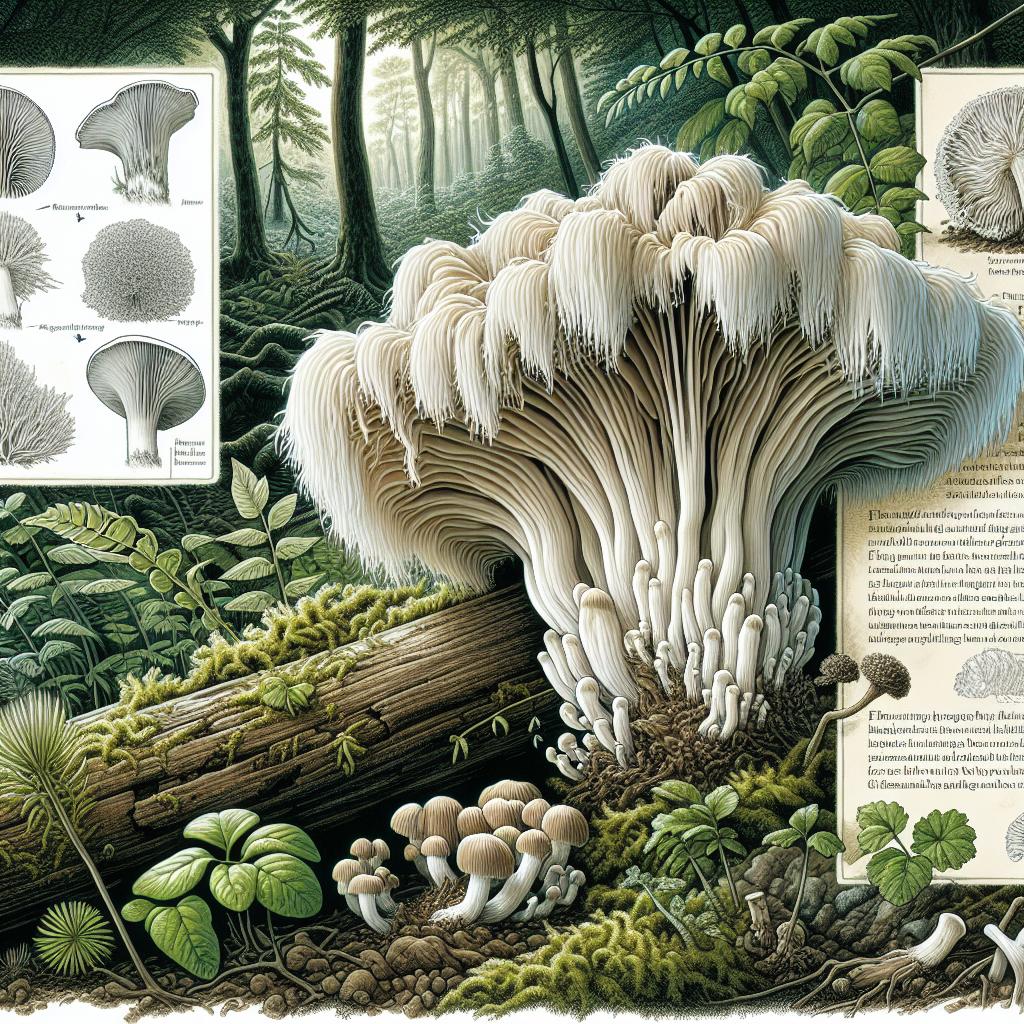
Embarking on a culinary adventure with the wild and elusive Lion’s Mane mushroom is truly an experience to savor. These shaggy, white gems hidden within the wooded embrace of nature are not just a source of nutrition but a delightful treasure to the palates of those lucky enough to find them. To partake in this foraging quest, seek out the Lion’s Mane in its natural habitat, often gracing the trunks of aging hardwoods, especially those trees that have bid adieu to their leafy crowns.
Identification is key in foraging to ensure an enjoyable and safe experience. Lion’s Mane is distinguishable by its cascading icicle-like spines rather than the traditional cap-and-stem structure common among other fungi. The fleshy pom-poms are mostly found during the late summer to fall, and spotting them can feel like finding gastronomic gold. Be assured by their unique appearance; there are no poisonous look-alikes, making them a forager’s delight.
To simplify the search, consider the following checklist:
- Habitat: Mature hardwood forests, particularly favoring wounded or fallen trees.
- Season: Late summer through fall, peeking just before the forest prepares for winter slumber.
- Appearance: White to cream-colored, with long cascading spines hanging from a single, thick base.
| Feature | Description |
|---|---|
| Color | Whitish, becoming creamy or yellowish with age |
| Texture | Dense and spongy when fresh |
| Spore Print | White |
| Taste | Comparable to seafood, with a hint of sweetness |
Armed with the knowledge of where to look and what to look for, remember that sustainable foraging is paramount. Harvest selectively, leaving enough behind to ensure that these fungal wonders can continue to proliferate for seasons to come. As you seek out the Lion’s Mane mushroom, you’re not just foraging, you’re connecting with the wild, and in that connection, the taste of the forest awaits to tantalize your senses.
Preserving the Delicacy: Tips for Storing and Preserving Lion’s Mane

Once you’ve had the pleasure of sampling the unique flavor profile of lion’s mane mushrooms, with their remarkable seafood-like taste reminiscent of crab or lobster, you’ll undoubtedly want to savor it again. To ensure every dish retains that sought-after flavor and texture, proper storage and preservation are key. Here are some expert tips to help you keep your lion’s mane mushrooms in top form.
Immediate Refrigeration is a must. Fresh lion’s mane mushrooms should be stored in the refrigerator as soon as possible. For optimal freshness, keep them in a paper bag to allow airflow and prevent moisture build-up, which can lead to spoilage. Steer clear of airtight containers or plastic bags for fresh mushrooms, as these environments can hasten deterioration.
- Keep mushrooms in the main compartment of the fridge, not the crisper.
- Use within 5-7 days for the best taste and texture.
For those with a penchant for longer preservation, dehydrating lion’s mane mushrooms is a superb method. The process concentrates the flavor and provides an almost indefinite shelf life when done correctly. Dehydrated mushrooms can be rehydrated when needed and used as a fresh substitute in cooking.
| Method | Temperature | Time |
|---|---|---|
| Food Dehydrator | 125°F (52°C) | 4-6 hours |
| Oven (Lowest Setting) | 150°F (65°C) | 1-2 hours |
If you’re a culinary enthusiast, pickling lion’s mane mushrooms can be an adventurous journey into flavor land. A simple brine of vinegar, water, salt, and your choice of spices can transform these mushrooms into a zesty, gourmet condiment that will elevate any meal.
- Blend spices like dill, garlic, and mustard seed for a classic pickling profile.
- Allow the mushrooms to marinate in the pickling solution for at least 48 hours for deep flavor infusion.
Whether you’re planning to use your lion’s mane mushrooms in a delectable risotto, a robust pasta dish, or as a decadent standalone treat, following these storage and preservation tips will assure your culinary experiences remain wild and wonderfully flavorful. Treat these majestic fungi with care, and they will reward you with a taste that’s truly out of this world.
Elevate Your Palate: Creative Recipes to Showcase Lion’s Mane Mushroom

Embark on a culinary journey by introducing the distinctive taste of the lion’s mane mushroom to your kitchen repertoire. Often described as having a flavor profile similar to seafood, particularly crab or lobster, this delectable fungus is not just a treat for the taste buds but also a powerhouse of nutrients. It’s no wonder that this ethereal-looking mushroom has found its way into the hearts of gourmet chefs and home cooks alike.
For the adventurous cook seeking to dial up the umami in their dishes, here’s a creative recipe to get you started: Lion’s Mane ‘Crab’ Cakes. Begin by shredding the mushroom into chunky, crab-like pieces. Combine with a mélange of bell peppers, scallions, and a dash of Old Bay seasoning. Bind the mixture with a touch of mayonnaise and dijon mustard, shape into patties, and pan-sear until golden brown. Serve with a spritz of lemon and a side of tangy remoulade for an unforgettable faux-seafood experience.
| Ingredient | Quantity |
|---|---|
| Lion’s Mane Mushroom | 2 cups shredded |
| Bell Peppers (diced) | 1/2 cup |
| Scallions (chopped) | 1/4 cup |
| Old Bay Seasoning | 1 tsp |
| Mayonnaise | 2 tbsp |
| Dijon Mustard | 1 tsp |
Not only can the lion’s mane mushroom stand in as a convincing substitute for seafood, but it can also elevate traditional recipes to new heights. Imagine a Velvety Lion’s Mane Alfredo where the natural lobster-like taste of the mushroom intertwines with a creamy, garlic-infused sauce, all nestled atop a bed of al dente fettuccine. To craft this dish, simply sauté your mushroom slices until tender, then fold into a homemade Alfredo concoction of butter, heavy cream, parmesan, and a pinch of nutmeg. The end result? A gourmet pasta dish that dances on the palate.
- Sauté and Simmer: Cook the lion’s mane until just tender to enhance its natural flavors.
- Create the Sauce: Whisk together butter, cream, and cheese for a sumptuous Alfredo sauce.
- Mix it Up: Combine the sautéed mushrooms with the pasta and sauce, garnish with parsley for a pop of color.
From the heartwarming embrace of a mushroom-infused risotto to the surprising twist of a lion’s mane mushroom stroganoff, the versatility of this ingredient will astound you. It’s time to make your mark in the kitchen by embracing the wild and wonderful taste of the lion’s mane mushroom. Take these creative recipes as a starting point and let your imagination run wild – the possibilities are truly endless.
Q&A
**Q: Can you describe the flavor of Lion’s Mane Mushroom for the uninitiated?**
A: Imagine, if you will, a gentle dive into a sea of flavor, where the Lion’s Mane Mushroom is the crest of a culinary wave. It’s a delightful contradiction, as it possesses a flavor profile that’s as unique as its shaggy, cascading appearance. Many liken it to the buttery richness of crab or lobster, with a meaty texture that’s astonishingly seafood-like. It’s subtly sweet and has a savory depth, providing a cozy umami goodness that tantalizes curious palates.
**Q: Is there a certain way to cook Lion’s Mane Mushroom to best capture its distinctive taste?**
A: Absolutely! To honor the delicate essence of Lion’s Mane, a light sautée in a bit of quality butter or olive oil can elevate its flavors marvelously. A sprinkle of salt and perhaps a touch of garlic or fresh herbs, and you’re letting this mushroom showcase its best qualities without overwhelming its natural charm. Think of it as a canvas that welcomes an artist’s touch but only requires a few thoughtful strokes.
**Q: Will the flavor of Lion’s Mane Mushroom appeal to all types of food enthusiasts?**
A: Lion’s Mane Mushroom is like a culinary chameleon, with its versatile taste profile that adapts to numerous recipes. Whether you’re a gourmet aficionado seeking the next taste sensation or a comfort-food lover looking for a twist on classic dishes, this mushroom’s distinct flavor offers something for everyone. Food adventurers will savor its exotic allure, while traditional palates will appreciate its comforting familiarity.
**Q: Is there more to this mushroom than just flavor—what about its nutritional benefits?**
A: Beyond its captivating taste, Lion’s Mane Mushroom presents a bounty of health benefits that further sweeten the deal. It’s packed with antioxidants and has been lauded for its cognitive-boosting properties, making it a favorite among those looking to support brain health. Low in calories yet high in fiber, it’s a gastronomic gift that nourishes the body as much as it pleases the taste buds.
**Q: What dishes would be ideal to introduce someone to Lion’s Mane Mushroom?**
A: If you’re crafting a culinary introduction to Lion’s Mane, think of dishes that benefit from a touch of savory elegance. A creamy risotto enriched with these mushrooms can be an excellent starting point, or perhaps a savory galette where its textures and flavors can truly shine. Even something as simple as a gourmet toast, crowned with sautéed Lion’s Mane, can be an epiphany, converting the curious into devout fans with just one bite.
**Q: How does Lion’s Mane hold up against other gourmet mushrooms in terms of taste and texture?**
A: Lion’s Mane Mushroom doesn’t just hold its ground in the gourmet mushroom arena—it stands proud, with its distinct taste and texture setting it apart from the earthy boldness of a Portobello or the delicate subtleties of Chanterelles. Its ability to mimic the taste and texture of seafood makes it an unparalleled choice for vegetarians and those looking to explore beyond the forest floor’s usual suspects.
Closing Remarks
And there you have it, adventurous foodies and curious cooks—the essence of the forest, the enigmatic Lion’s Mane mushroom, revealed on your palate. But don’t just take our word for it; indulge in the experience yourself. Step beyond the mundane and add a touch of wild wonder to your dishes. Whether you’re enhancing a creamy risotto or transforming a simple soup, this delicacy is set to become the mane attraction on your plate.
Remember, the Lion’s Mane isn’t just a gastronomic delight—it’s a journey, a story of flavor that promises to whisk you away to an untouched woodland with every bite. So, dare to savor the extraordinary, and let your taste buds roar with pleasure. Share your culinary exploits with us, and together, let’s continue to explore the boundless wonders that nature serves up. The question isn’t just “What does Lion’s Mane mushroom taste like?” The real question is, “Are you ready to taste the wild?


















